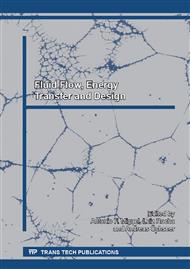p.9
p.20
p.27
p.40
p.51
p.58
p.64
p.71
p.88
Oily Water Treatment Using Ceramic Membrane in Presence of Swirling Flow Induced by a Tangential Inlet via CFD
Abstract:
In recent years, attention has been given to the processes controlling the emission of oily effluents and their environmental impact. Many industrial processes generate large volumes of water contaminated with oil, called oily waters. The oily water must be treated before its discard in order to meet the criteria established by environmental agencies (for example in Brazil, 20 mg/L). In present days, the process of separating oil/water with ceramic membranes has attracted the attention of many researchers [1,2]. In this sense, the aim of this study is to evaluate the influence of the tangential inlet shape in the oil/water separation via ceramic membranes. We use a mathematical multiphase flow model to describe the oil-water separation, based on the particle model. Here oil is the dispersed phase while water the continuous phase. To model the turbulence effect we use the RNG k-ε model. All simulations were carried out using the Ansys CFX ® commercial code. Results of streamlines and velocity, pressure and volume fraction of phase fields are present and analyzed. The numerical results indicate that no significant difference when using a circular or rectangular pipe with the same cross-sectional area.
Info:
Periodical:
Pages:
51-57
Citation:
Online since:
January 2014
Keywords:
Price:
Сopyright:
© 2014 Trans Tech Publications Ltd. All Rights Reserved
Share:
Citation:



